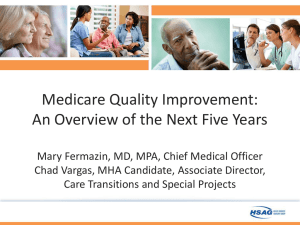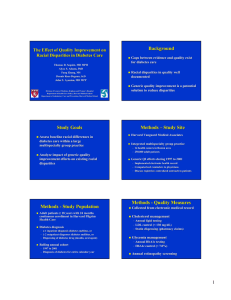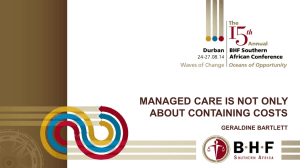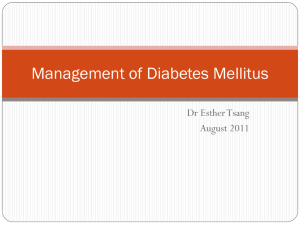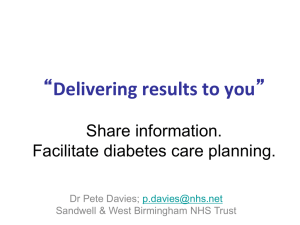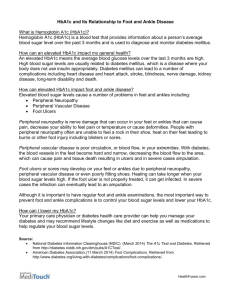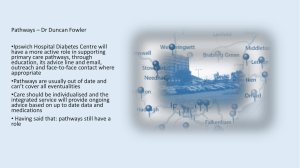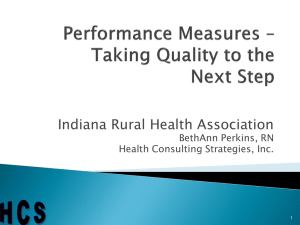Presentation - Right Care Initiative
advertisement
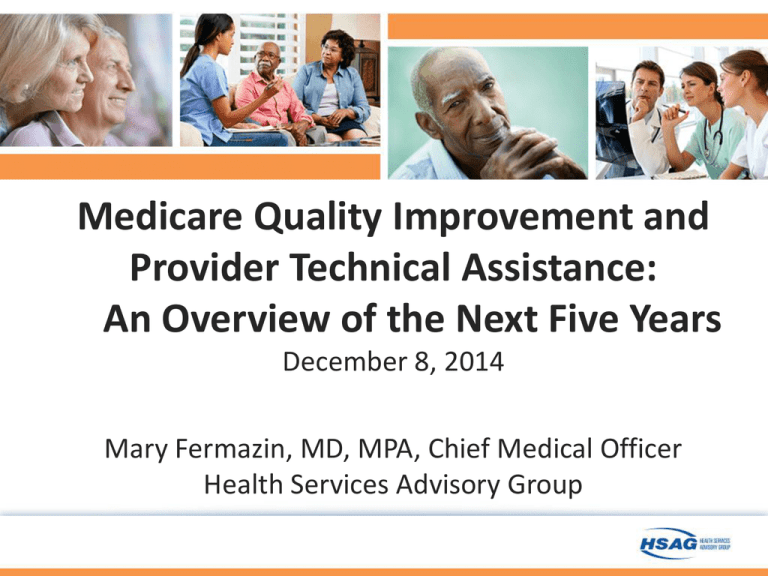
Medicare Quality Improvement and Provider Technical Assistance: An Overview of the Next Five Years December 8, 2014 Mary Fermazin, MD, MPA, Chief Medical Officer Health Services Advisory Group Presentation Outline • A review of QIN-QIO’s scope of work in general, with special emphasis on the work with physician practices • Technical Assistance to Providers – Million Hearts campaign – Chronic care management of diabetes care • Patient Community Meetings – Diabetes Self Management Education – Check.Change.Control 2 QIN-QIO Framework 3 QIN- QIO : Results Oriented Quality Improvement • Serve as neutral convener and actively engage providers, partners and patients • Utilize data as core component of QI efforts, provide regular data feedback reports • Use Learning and Action Networks to facilitate rapid learning, disseminate best practices that lead to system changes and sustainable results • Provide focused technical assistance and coaching 4 Chronic Care Model 5 Cardiac Health HealthcareAcquired Conditions in Nursing Homes Value-Based Payment Program Disparities in Diabetes Patient is at the center of care. Coordination of Care 6 HealthcareAssociated Infections in Hospitals Chronic Disease Management Through Meaningful Use Improve Cardiac Health and Reduce Disparities • Implement evidence-based practices to improve cardiovascular health • Support Million Hearts® initiative • Promote the use of Aspirin, Blood pressure control, Cholesterol management, and Smoking assessment and cessation (ABCS) – Work with racial and ethnic minority beneficiaries/dualeligibles, and providers to improve ABCS 7 Technical Assistance • Million Hearts – Physician Quality Reporting System using EHR – EHR reports on patients with hypertension – Workflow analysis and redesign for managing patient panels – Controlling High BP; Tobacco Use: Screening and Cessation; IVD: Use of Aspirin or Another Antithrombotic; and Fasting LDL-C Test Performed and Stratified 8 Technical Assistance • TA focus: those providers who manage patients with the greatest cardiovascular health needs and those most challenged to succeed in implementing evidence-based practices to improve cardiovascular health and support the Million Hearts® initiative. • Eligible Providers – Current measures below Million Hearts goal of 65% – Target providers who serve racial and ethnic minority Medicare beneficiaries, dual-eligible Medicaid and Medicare beneficiaries 9 Reduce Disparities in Diabetes Care: Everyone with Diabetes Counts • Improve HbA1c, lipids, blood pressure, and weight control – Combination of provider-based and community-based strategies • Decrease number of beneficiaries requiring lowerextremity amputations – Claims data evaluation and aggregation of data for the state and the QIN-QIO area 10 Reduce Disparities in Diabetes Care: Self Management Education Training Classes • Use train-the-trainer program to increase the number of certified diabetes educators and community health workers • Refer diabetic patients from recruited medical providers • Use community-based approach to encourage program spread 11 Reduce Disparities in Diabetes Care: Increase Adherence of Utilization Measures • Includes HbA1c, lipids, eye and foot exams – Provider engagement strategies – Clinical data input and reporting through EHR – Reporting on eye exams and foot exams 12 Technical Assistance • Chronic care management of diabetes care – EHR reports on patients with hypertension – Workflow analysis and redesign for managing patient panels – Increasing adherence to clinical guidelines for appropriate use of utilization measures for HbA1c, Lipids, and Eye Exams – Decrease lower extremity amputations – Refer patients with diabetes to DSME 13 Technical Assistance TA Focus: • At least 25% of a Participating Practitioner Clinics/Offices/Practices Medicare diabetes patient population are a racial or ethnic minority/rural/ or in an underserved area • Based on analysis of Medicare claims, each Participating Practitioner Clinic/Office/Practice with claims results ranked in the lower 50th percentile among all practices in the QIN-QIO area for at least two of the three utilization measures: HbA1c, Lipids, and Eye Exam. (FQHCs and RHCs are exempt) 14 Quality Improvement through Value-Based Payment Programs • Increase number of eligible physicians and physician groups submitting data through Physician Quality Reporting System (PQRS) • Demonstrate improvement in quality of care delivered by physician groups and hospital outpatient departments • Increase national performance levels on hospital VBP measures • Increase percentage of ambulatory surgery centers and inpatient psychiatric facilities that improve quality on poorly performing quality measures 15 Patient Community Meetings • Engage patients and families in the community through meetings where they congregate: – Senior centers – Faith-based organizations – Libraries • Engage partners in patient community meetings, such as providers, the American Heart Association, clinical pharmacists, etc. to educate patients on: – – – – 16 Self management of chronic disease Patient portals Medication safety Availability of community health resources Questions? Mary Fermazin|818.265.4657|mfermazin@hsag.com Chad Vargas|818.265.4688|cvargas@hsag.com Kim Salamone |602.801.6960|ksalamone@hsag.com This material was prepared by Health Services Advisory Group, Inc., the Medicare Quality Improvement Organization for California, under contract with the Centers for Medicare & Medicaid Services (CMS), an agency of the U.S. Department of Health and Human Services. The contents presented do not necessarily reflect CMS policy. Publication No.CA-11SOW-B.1-09242014-02
